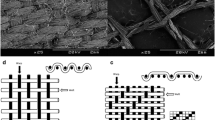Abstract
Patches of fabrics exposed to pesticide spray formulations lost substantial quantities of the chemicals within four to six hours. Fabrics were cotton or 1∶1 cotton-polyester blends, knitted or woven, unfinished or finished. Pesticides used were parathion, malathion, and dicofol. Parathion loss following exposure to spray formulations was dependent on fabric type, finish and their interaction, while a less extensive loss of dicofol depended on none of these. Deposition and retention of pesticide-bearing particulates appeared to depend on mechanical restrictions related to fabric weave and on the electrokinetic potential of fabric surfaces.
Similar content being viewed by others
References
Adams, J. D., Y. Iwata, and F. A. Gunther: Worker environment research. IV. The effect of dust derived from several soil types on the dissipation of parathion and paraoxon dislodgable residues on citrus foliage. Bull. Environ. Contam. Toxicol.15, 547 (1976).
Adams, J. D., Y. Iwata, and F. A. Gunther: Worker environment research. V. Effect of soil dusts on dissipation of paraoxon dislodgable residues on citrus foliage. Bull. Environ. Contam. Toxicol.18, 445 (1977).
Durham, W. F., and H. R. Wolfe: Measurement of the exposure of workers to pesticides. Bull. World Hlth. Org.26, 75 (1962).
Ellzey, S. E., Jr., W. J. Connick, G. L. Drake, Jr., and W. A. Reeves: Oil-repellent finish for cotton based on fluorinated amines. Textile Res. J.39, 809 (1969).
Finley, E. L., and J. R. B. Rogillio: DDT and methyl parathion residues found in cotton and cotton-polyester fabrics worn in cotton fields. Bull. Environ. Contam. Toxicol.4, 343 (1969).
Franklin, C. A., R. A. Fenske, R. Greenhalgh, L. Mathiew, H. V. Denley, J. T. Leffingwell, and R. C. Spear: Correlation of urinary pesticide metabolite excretion with estimated dermal contact in the course of occupational exposure to guthion. J. Toxicol. Environ. Hlth. In press (1981).
Hansen, J. D., A. B. Schneider, B. M. Olive, and J. J. Bates: Personnel safety and foliage residue in an orchard spray program using azinphosmethyl and captan. Arch. Environ. Contam. Toxicol.7, 63 (1978).
Heuer, H., B. Yaron, and Y. Birk: Guthion half-life in aqueous solutions and on glass surfaces. Bull. Environ. Contam. Toxicol.11, 532 (1974).
Knaak, J. B., K. T. Maddy, M. A. Gallo, D. T. Lillie, E. M. Craine, and W. F. Serat: Worker reentry study involving phosalone application to citrus groves. Toxicol. Appl. Pharmacol.46, 363 (1978).
Lavy, T. L., J. S. Shepard, and J. D. Mattice: Exposure measurements of applicators spraying (2,4,5-trichlorophenoxy) acetic acid in the forest. J. Agr. Food Chem.28, 626 (1980).
Lavy, T. L.: Determination of 2,4-D exposure received by forestry applicators. Project completion report to National Forest Products Association. August 29 (1980).
Lichtenstein, P. E., and K. R. Schulz: Volatilization of insecticides from various substrates. J. Agr. Food Chem.18, 814 (1970).
Moreau, J. P., S. E. Ellzey, Jr., and G. L. Drake: Perfluoroester-aziridine oil repellent finish for cotton. Am. Dyestuff Reptr.56, 38 (1967).
Penny, G. W.: Collection of electrically charged particles in filters. J. Air Poll. Contr. Assn.26, 58 (1976).
Pittman, A. G., J. N. Roitmann, and D. Sharp: Hydrophilicity in fluorochemical stain release polymers. Textile Chemist and Colorist.3, 175 (1971).
Popendorf, W., R. C. Spear, J. T. Leffingwell, J. Yager, and E. Kahn: Harvester exposure to zolone (phosalone) residues in peach orchards. J. Occup. Med.21, 189 (1979).
Que Hee, S. S., R. G. Sutherland, K. S. McKinlay, and J. G. Saha: Factors affecting the volatility of DDT, dieldrin, and dimethylamine salt of 2,4-dichlorophenoxy acetic acid (2,4-D) from leaf and grass surfaces. Bull. Environ. Contam. Toxicol.13, 284 (1975).
Quinby, G. E., K. C. Walker, and W. F. Durham: Public health hazards involved in the use of organic phosphorus insecticide in cotton culture in the delta area of Mississippi. J. Econ. Entomol.51, 831 (1958).
Schiefer, H. F., and P. M. Boyland: Improved instrument for measuring the air permeability of fabrics. J. Res. Natl. Bureau Std.28, 637 (1942).
Serat, W. F., A. J. Van Loon, and W. H. Serat: Some factors influencing the design of fabrics for protective garments for pesticide field workers. California Department of Health Services, Berkeley, California: Community Studies on Pesticides (1978).
Smith, S., and P. O. Sherman: The physical chemistry of stain release. Textile Chemist and Colorist.1, 20 (1969).
Spear, R. C., W. Popendorf, J. T. Leffingwell, T. H. Milby, J. E. Davies, and W. F. Spencer: Fieldworkers' response to weathered residues of parathion. J. Occup. Med.19, 406 (1977).
Spear, R. C., D. Jenkins, and T. H. Milby: Pesticide residues and field workers. Environ. Sci. Technol.9, 308 (1975).
Ware, G. W., D. P. Morgan, B. J. Estensen, and W. P. Cahill: Establishment of reentry time intervals for organophosphate-treated cotton fields based on human data: III. 12 to 72 hours post treatment exposure to monocrotophos, ethyland methyl-parathion. Arch. Environ. Contam. Toxicol.3, 289 (1975).
Winterlin, W., J. B. Bailey, L. Langbehn, and C. Mourer: Degradation of parathion applied to peach leaves. Pestic. Monit. J.8, 263 (1975).
Wolfe, H. R., J. F. Armstrong, C. D. Staiff, S. W. Comer, and W. F. Durham: Exposure of apple thinners to parathion residues. Arch. Environ. Contam. Toxicol.3, 257 (1975).
Woodrow, J. E., J. N. Weiber, D. G. Crosby, K. W. Moilanen, C. J. Soderquist, and C. Mourer: Airborne and surface residues of parathion and its conversion products in a treated plum orchard environment. Arch. Environ. Contam. Toxicol.6, 175 (1977).
Zepp, R. G., N. L. Wolfe, J. A. Gordon, and G. L. Baughman: Dynamics of 2,4-D esters in surface waters. Environ. Sci. Technol.9, 1144 (1975).
Zisman, W. A.: Contact angle, wettability and adhesion. Adv. Chem. Series, No. 43 (1964).
Author information
Authors and Affiliations
Rights and permissions
About this article
Cite this article
Serat, W.F., Van Loon, A.J. & Serat, W.H. Loss of pesticides from patches used in the field as pesticide collectors. Arch. Environ. Contam. Toxicol. 11, 227–234 (1982). https://doi.org/10.1007/BF01054900
Received:
Accepted:
Issue Date:
DOI: https://doi.org/10.1007/BF01054900




